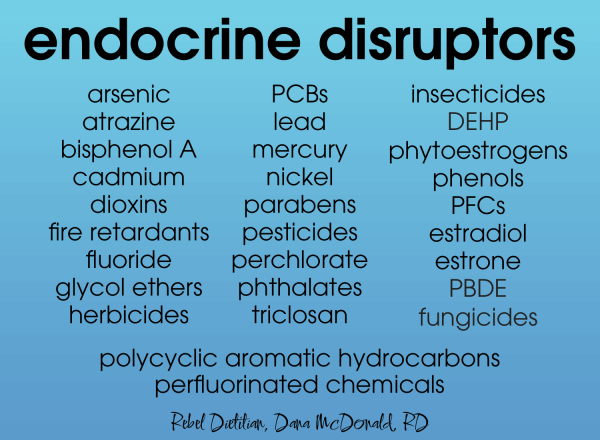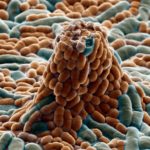
Uma pequena lista das substâncias que feminizam os machos e geram doenças como câncer de mama
http://www.brjd.com.br/index.php/BRJD/article/view/4481
Brazilian Journal of Development
Home > Vol 5, No 11 (2019) > Barros
Dayane de Melo Barros, Marcela de Albuquerque Melo, Claudinelly Yara Braz dos Santos, Andressa da Silva Pereira, Amanda Felix de Sousa, Andressa Thauany de Sousa Alves, Juliana de Oliveira Costa, Thiago da Silva Freitas, Maria Edilza Mendonça dos Santos, Secineide Santana de Carvalho, Túlio Albuquerque Jacobine, José Hélio Luna da Silva, Gisele Barbosa de Aguiar, Ana Cláudia Barbosa da Silva Padilha, Tamiris Alves Rocha, Silvio Assis de Oliveira Ferreira, Danielle Feijó de Moura
Full Text:
Abstract
Os Disruptores Endócrinos (DEs) são substâncias que influenciam nas atividades orgânicas do sistema endócrino do corpo humano. Nas últimas décadas, tem-se aumentado o interesse da comunidade científica e da mídia acerca dos possíveis efeitos danosos causados aos seres humanos pela exposição a essas substâncias químicas. Este estudo objetivou realizar uma revisão de literatura sistemática sobre os conceitos destas substâncias químicas, seus efeitos na saúde humana e mecanismo de ação. Foi realizado um levantamento bibliográfico por meio das bases de dados Biblioteca Virtual em Saúde (BVS) e Scielo, site institucional e livros entre os anos de 1999 e 2019, nos idiomas português e inglês. Os dados obtidos indicaram o impacto dos DEs na obesidade, diabetes, sistema cardiovascular, síndrome dos ovários policísticos, carcinogenicidade e sistema tireoideano. Logo, os DEs são substâncias que afetam a saúde humana, uma vez que, vários estudos indicam interferência endócrina dessas substâncias, as quais repercutem em danos ao organismo.
Keywords
Atividades orgânicas. Corpo humano. Disruptores Endócrinos. Revisão de literatura.
References
ASSUNÇÃO, J.V.; PESQUERO, C. R. Dioxinas e furanos: origens e riscos. Revista de Saúde Pública, v. 33, n. 5, 1999.
BADAJOZ, E.S.; LAGE-SÁNCHEZ, J. M.; SÁNCHEZ-GALLEGOS, P. Disruptores Endocrinos y Cáncer de Próstata. Archivos españoles de urología, v. 3, n. 70, p.331-335, 2017.
BAIRD, C. Química ambiental. 2. ed., Porto Alegre: Bookman, 622 p, 2002.
BENEDETTI, M.; ZONA, A.; BECCALONI, E.; CARERE, M.; COMBA, P. Incidence of Breast, Prostate, Testicular, and Thyroid Cancer in Italian Contaminated Sites with Presence of Substances with Endocrine Disrupting Properties. International Journal of Environmental Research and Public Health, v. 14, n. 4, p.355-365, 2017. DOI: http://dx.doi.org/10.3390/ijerph14040355.
BILA, D. M.; DEZOTTI, M. Desreguladores endócrinos no meio ambiente: efeitos e consequências. Química nova, v.30, n.3, p.651, 2007. DOI: http://dx.doi.org/10.1590/S0100-40422007000300027.
BURKS, H.; PASHOS, N.; MARTIN, E.; MCLACHLAN, J.; BUNNELL, B.; BUROW, M. Endocrine disruptors and the tumor microenvironment: A new paradigm in breast cancer biology. Molecular and Cellular Endocrinology, v. 457, p.13-19, 2017. DOI: http://dx.doi.org/10.1016/j.mce.2016.12.010.
CALSOLARO, V.; PASQUALETTI, G.; NICCOLAI, F.; CARACCIO, N.; MONZANI, F. Thyroid Disrupting Chemicals. International Journal Of Molecular Sciences, v. 18, n. 12, p.2566-2583, 1 dez. 2017. MDPI AG. DOI: http://dx.doi.org/10.3390/ijms18122583.
DARBRE, P.D. Endocrine Disruptors and Obesity. Current Obesity Reports, v. 6, n. 1, p.18-27, 2017. http://dx.doi.org/10.1007/s13679-017-0240-4.
DIAMANTI-KANDARAKIS, E.; BOURGUIGNON, J. P.; GIUDICE, L. C.; HAUSER, R.; PRINS, G. S.; SOTO, A. M.; ZOELLER, R.T; GORE, A. C. Endocrine-Disrupting Chemicals: An Endocrine Society Scientific Statement. Endocrine Reviews, v. 30, n. 4, p.293-342, 2009. DOI: http://dx.doi.org/10.1210/er.2009-0002.
EPA. Special Report on Environmental Endocrine Disruption: An Effects Assessment and Analisys, U.S. Environmental Protection Agency, Report No. EPA/630/R-96/012, Washington, DC., 111p, 1997.
FÉNICHEL, P.; CHEVALIER, N. Environmental endocrine disruptors: New diabetogens?. Comptes Rendus Biologies, v. 340, n. 9-10, p.446-452, 2017. DOI: http://dx.doi.org/10.1016/j.crvi.2017.07.003.
GHISELLI, G.; JARDIM, W. F. Interferentes endócrinos no ambiente. Química Nova, v. 30, n. 3, p. 695-706, 2007. DOI: http://dx.doi.org/10.1590/S0100-40422007000300032.
GIACCO, F.; BROWNLEE, M. Oxidative Stress and Diabetic Complications. Circulation Research, v. 107, n. 9, p.1058-1070, 2010. DOI: http://dx.doi.org/10.1161/circresaha.110.223545.
GIULIVO, M.; ALDA, M.L;. CARPI, E.; BARCELÓ, D. Human exposure to endocrine disrupting compounds: Their role in reproductive systems, metabolic syndrome and breast cancer. A review. Environmental Research, v. 151, p.251-264, 2016. DOI: http://dx.doi.org/10.1016/j.envres.2016.07.011.
GORE, A. C.; CREWS, D.; DOAN, L.L.; MERRIL, M.L.; PATISAUL, H.; ZOTA, A. Introdução aos Disruptores Endócrinos (DEs) um guia para governos e organizações de interesse público. Endocrine Society, p. 1-76, 2014.
GUIMARÃES, J. R. P. F. Disruptores endócrinos no meio ambiente: um problema de saúde pública e ocupacional. Santos. ACPO, 2005.
IPCS. Global Assessment of the: State- of- the –Science of Endocrine Disrupors, International Programme on Chemical Safety Report WHO/PCS/EDC/02.2, World Health Organization (WHO), Geneva, Switzerland; Damstra, T.; Barlow, S.; Bergmna, A.; Kavlock, R.; Van Der Kraak, G., eds.; 2002.
JANESICK, A.; BLUMBERG, B. Endocrine disrupting chemicals and the developmental programming of adipogenesis and obesity. Birth Defects Research Part C: Embryo Today, v. 93, n. 1, p.34-50, 2011. DOI: http://dx.doi.org/10.1002/bdrc.20197.
KABIR, E. R.; RAHMAN, M. S.; RAHMAN, I. A review on endocrine disruptors and their possible impacts on human health. Environmental Toxicology and Pharmacology, v. 40, n. 1, p.241-258, 2015. DOI: http://dx.doi.org/10.1016/j.etap.2015.06.009.
KONIECZNA, A.; RACHON, D.; OWCZAREK, K.; KUBICA, P.; KOWALEWSKA, A.; KUDŁAK, B.; WASIK, A.; NAMIESNIK, K. Serum bisphenol A concentrations correlate with serum testosterone levels in women with polycystic ovary syndrome. Reproductive Toxicology, v. 82, p.32-37. DOI: http://dx.doi.org/10.1016/j.reprotox.2018.09.006.
LARINI, L. Toxicologia dos praguicidas. São Paulo: Manole, 230 p, 1999.
LEGLER, J. FLETCHER,T.; GOVARTS,E.; PORTA,M; BLUMBERG,B.; HEINDEL, J.J.; TRASANDE,L.; Obesity, Diabetes, and Associated Costs of Exposure to Endocrine-Disrupting Chemicals in the European Union. The Journal Of Clinical Endocrinology & Metabolism, v. 100, n. 4, p.1278-1288, abr. 2015. DOI: http://dx.doi.org/10.1210/jc.2014-4326.
LORDELO, R. A.; MANCINI, M. C.; CERCATO, C.; HALPERN, A. Eixos hormonais na obesidade: causa ou efeito?. Arquivos Brasileiros de Endocrinologia & Metabologia, v.51, n.1, p.34-41, 2007.
MAQBOOL, F.; MOSTAFALO, S.; BAHADAR, H.; ABDOLLAH, M. Review of endocrine disorders associated with environmental toxicants and possible involved mechanisms. Life Sciences, v. 145, p.265-273, 2016. DOI: http://dx.doi.org/10.1016/j.lfs.2015.10.022.
MAQBOOL, F.; SAFAVI, M.; BAHADAR H.; RAHIMIFARD, M.; NIAZ, K. ABDOLLAHI, M. Discovery Approaches for Novel Dyslipidemia Drugs. Current Drug Discovery Technologies, v. 12, n. 2, p.90-116, 2015. DOI: http://dx.doi.org/10.2174/1570163812666150702121809.
MEYER, A.; SARCINELLI, P.N.; MOREIRA, J.C. Estarão alguns grupos populacionais brasileiros sujeitos à ação de disruptores endócrinos?. Cadernos de Saúde Pública, v.15, n.4, p.845-850, 1999.
MIMOTO, M. S.; NADAL, A.; SARGIS, R. M. Polluted Pathways: Mechanisms of Metabolic Disruption by Endocrine Disrupting Chemicals. Current Environmental Health Reports, v. 4, n. 2, p.208-222, 2017. DOI: http://dx.doi.org/10.1007/s40572-017-0137-0.
MINISTÉRIO DA SAÚDE DO BRASIL. Portaria 1.339 de 18 de novembro de 1999. In: Doenças relacionadas ao trabalho. Brasília: Ministério da Saúde do Brasil, 580 p, 2001.
MNIF, W.; HASSINE, A.I.H.; BOUAZIZ, A.; BARTEGI, A.; THOMAS, O.; ROIG, B. Effect of Endocrine Disruptor Pesticides: A Review. International Journal Of Environmental Research and Public Health, v. 8, n. 6, p.2265-2303, 2011. DOI: http://dx.doi.org/10.3390/ijerph8062265.
MORAES, N. V.; GRANDO, M. D.; VALERIO, D. A. R.; OLIVEIRA, D. P. Exposição ambiental a desreguladores endócrinos: alterações na homeostase dos hormônios esteroidais e tireoideanos. Revista Brasileira de Toxicologia, v. 21, n. 1, p. 1-8, 2008.
PATNAIK, P. Guia geral: propriedades nocivas das substâncias químicas. Belo Horizonte: Ergo, v. 1, 546 p, 2002.
PONTELLI, R. C. N.; NUNES, A. A.; OLIVEIRA, S. V. W. B. Impacto na saúde humana de disruptores endócrinos presentes em corpos hídricos: existe associação com a obesidade?. Ciência & Saúde Coletiva, v.21, p. 753-766, 2016.
REIS FILHO, R. W.; LUVIZOTTO-SANTOS, R.; VIEIRA, E. M. Poluentes emergentes como desreguladores endócrinos. Journal of the Brazilian Society of Ecotoxicology, v. 2, n. 3, p. 283-288, 2007.
ROMANO, M.E.; SAVITZ, D. A.; BRAUN, J. M. Challenges and Future Directions to Evaluating the Association Between Prenatal Exposure to Endocrine-Disrupting Chemicals and Childhood Obesity. Current Epidemiology Reports, v. 1, n. 2, p.57-66, 2014. DOI: http://dx.doi.org/10.1007/s40471-014-0007-3.
RUTKOWSKA, A. Z.; DIAMANTI-KANDARAKIS, E. Polycystic ovary syndrome and environmental toxins. Fertility and Sterility, v. 106, n. 4, p.948-958, 2016. Elsevier BV. DOI: http://dx.doi.org/10.1016/j.fertnstert.2016.08.031
SANTAMARTA, J. A ameaça dos disruptores endócrinos. Revista Agroecologia e Desenvolvimento Rural Sustentável, Porto Alegre, v.2, n.3, p.18-29, 2001.
SCHAFFER, S.W.; JONG, C. J.; MOZAFFARI, M. Role of oxidative stress in diabetes-mediated vascular dysfunction: Unifying hypothesis of diabetes revisited. Vascular Pharmacology, v. 57, n. 5-6, p.139-149. DOI: http://dx.doi.org/10.1016/j.vph.2012.03.005.
SILVA, M. C.; CONFORTI, V. A. Disruptores Endócrinos. Enciclopédia Biosfera, Centro Científico Conhecer. Goiânia, v.9, n.17; p. 1098, 2013.
VAN MAELE-FABRY, G.; GAMET-PAYRASTRE, L.; LISON, D. Household exposure to pesticides and risk of leukemia in children and adolescents: Updated systematic review and meta-analysis. International Journal of Hygiene and Environmental Health, v. 222, n. 1, p.49-67, 2019. DOI: http://dx.doi.org/10.1016/j.ijheh.2018.08.004.
WAISSMANN, W. Health surveillance and endocrine disruptors. Cadernos de Saúde Pública, v.18, n.2, p.511-517, 2002.
ZAREAN, M.; POURSAFA, P. The Role of Environmental Disruptor Chemicals in the Development of Non Communicable Disease. Advances In Experimental Medicine And Biology, p.21-31, 2019. DOI: http://dx.doi.org/10.1007/978-3-030-10616-4_3.
ZHU, M.; Wu, J.; MA, X.; HUANG, C.; WU, R.; ZHU, W.; LI, X.; LIANG, Z.; DENG, F.; ZHU, J.; XIE, W.; YANG, X.; JIANG, Y.; WANG, S.; GENG, S.; XIE, C.; ZHONG, C. Butyl benzyl phthalate promotes prostate cancer cell proliferation through miR-34a downregulation. Toxicology In Vitro, v. 54, p.82-88. DOI: http://dx.doi.org/10.1016/j.tiv.2018.09.007.
DOI: https://doi.org/10.34117/bjdv5


